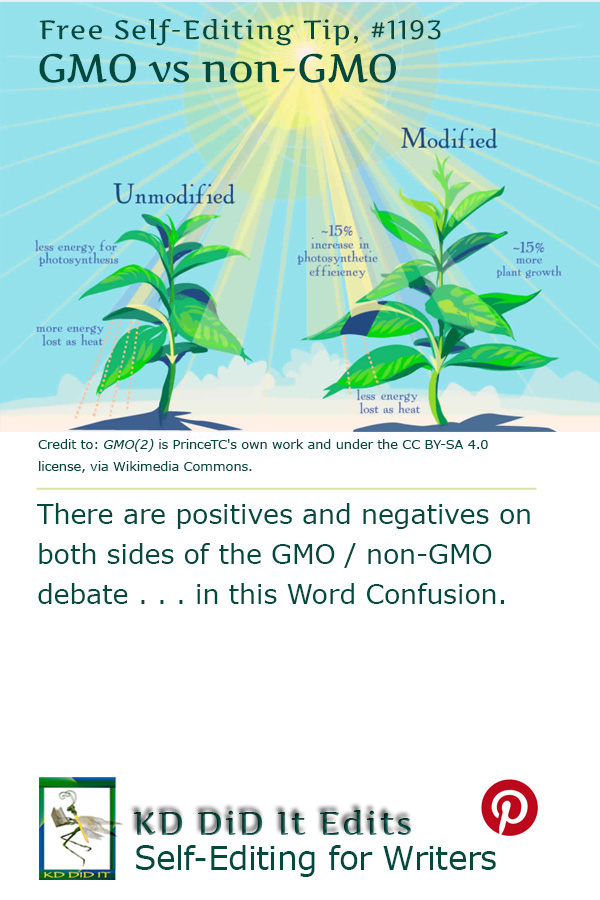I know, it’s not really a word confusion, but I was curious about GMO versus non-GMO, especially when a friend pointed out the new term for GMO. I don’t know if the chemical companies are hoping to downplay the stigma of GMO or what, but the new term for GMO is bioengineered.
All things considered, humanity has been genetically modifying organisms for over 30,000 years through selective breeding. “The earliest evidence of artificial selection of plants dates back to 7800 BCE in archaeological sites found in southwest Asia.” So, GMO is nothing new. What is new is the stranglehold the major chemical companies have over who can use their seeds.
Credit to: Rangel
Word Confusions . . .
. . . started as my way of dealing with a professional frustration with properly spelled words that were out of context in manuscripts I was editing as well as books I was reviewing. It evolved into a sharing of information with y’all. I’m hoping you’ll share with us words that have been a bête noire for you from either end.
If you found this post on “GMO vs Non-GMO” interesting, consider subscribing to KD Did It, if you’d like to track this post for future updates.
| GMO | Non-GMO |
|---|---|

GMO Banana? by Steve Bussinne is in the public domain, via Free Range Stock. |

The Hemp Organic, Gluten-Free, Non GMO, BIO, Vegan Pop Chips is TheHempOfficial‘s own work under the CC BY-SA 4.0 license, via Wikimedia Commons. |
| Part of Grammar: | |
| Noun
Plural: GMOs a.k.a. GE, GM |
Noun
Plural: non-GMOs |
| Genetically modified organism whose genome has been engineered in the laboratory in order to favor the expression of desired physiological traits or the generation of desired biological products | Non-genetically modified organism
A product produced without genetic engineering and its ingredients are not derived from GMOs |
| Examples: | |
| “Say goodbye to GMOs. The new term for foods created with a boost from science is “bioengineered. . . . as of Jan. 1 [2022]” (Hernandez).
The majority of GMO crops are grown in the Americas and more than two dozen countries worldwide. A GMO corn resists insect pests and tolerates herbicides. Two types of GMO rice have been modified to enhance iron absorption and increase beta-carotene production. GMO mosquitoes were produced that block entry of the malaria parasite. “GMOs may be used for a variety of purposes, such as making human insulin, producing fermented beverages, and developing pesticide resistance in crop plants” (Smith). “GMO crops are not about feeding the world but about patented ownership of the food supply” (GMO FAQs). Foods claiming to be organic may not have GMOs in any part of the production process. |
“Non-GMO crops are free of harsh chemical fertilizers and toxic pesticides, meaning you’ll avoid ingesting them when you’re consuming your favorite foods” (Why).
Lentils, quinoa, and most beans are almost always non-GMO. Nuts are non-GMO and those highest in protein include almonds, walnuts, cashews, and peanuts. “Non-GMO and locally adapted seeds leave a legacy of resilient crops for future generations” (Waddell). |
| History of the Word: | |
| 1973 with a breakthrough by Herbert Boyer and Stanley Cohen who worked together to engineer the first successful genetically engineered (GE) organism. | 2007?, when two natural food retailers — Natural Grocery Company in Berkeley, California, and The Big Carrot Natural Food Market — formed the NON GMO Project, with a goal of creating a standardized definition for non-genetically modified organisms. |
C’mon, get it out of your system, bitch, whine, moan . . . which words are your pet peeves? Also, please note that I try to be as accurate as I can, but mistakes happen or I miss something. Email me if you find errors, so I can fix them . . . and we’ll all benefit!
Satisfy your curiosity about other Word Confusions on its homepage or more generally explore the index of self-editing posts. You may also want to explore Book Layout & Formatting Ideas, Formatting Tips, Grammar Explanations, Linguistics, Publishing Tips, the Properly Punctuated, Writing Ideas and Resources, and Working Your Website.
Resources for GMO vs Non-GMO
Britannica: genetically modified organism
“GMO FAQs.” Non GMO Project. n.d. Web. 17 July 2023. <https://www.nongmoproject.org/gmo-faq/>.
Hernandez, Joe. “GMO is Out, ‘Bioengineered’ is in, as New US Food Labeling Rules Take Effect.” NPR.org. 5 Jan 2022. Web. 17 July 2023. <https://www.npr.org/2022/01/05/1070212871/usda-bioengineered-food-label-gmo>.
Rangel, Gabriel. “From Corgis to Corn: A Brief Look at the Long History of GMO Technology.” Science in the News. Harvard University. 9 Aug 2015. Web. 17 July 2023. <https://sitn.hms.harvard.edu/flash/2015/from-corgis-to-corn-a-brief-look-at-the-long-history-of-gmo-technology/>.
Smith, Dr Mike. “Genetically Modified Organism (GMO).” National Human Genome Research Institute. 17 July 2023. Web. 17 July 2023. <https://www.genome.gov/genetics-glossary/Genetically-Modified-Organism>.
Waddell, Melissa. “6 Benefits of Going Non-GMO.” Non GMO Project. 26 Jan 2022. Web. 17 July 2023. <https://www.nongmoproject.org/blog/6-benefits-to-going-non-gmo/>.
“Why We Use Non-GMO Ingredients.” All Y’alls Foods. n.d. Web. D17 July 2023ATE. <https://allyallsfoods.com/pages/why-non-gmo-ingredients>.
Pinterest Photo Credits
GMO(2) is PrinceTC‘s own work and under the CC BY-SA 4.0 license, via Wikimedia Commons.


